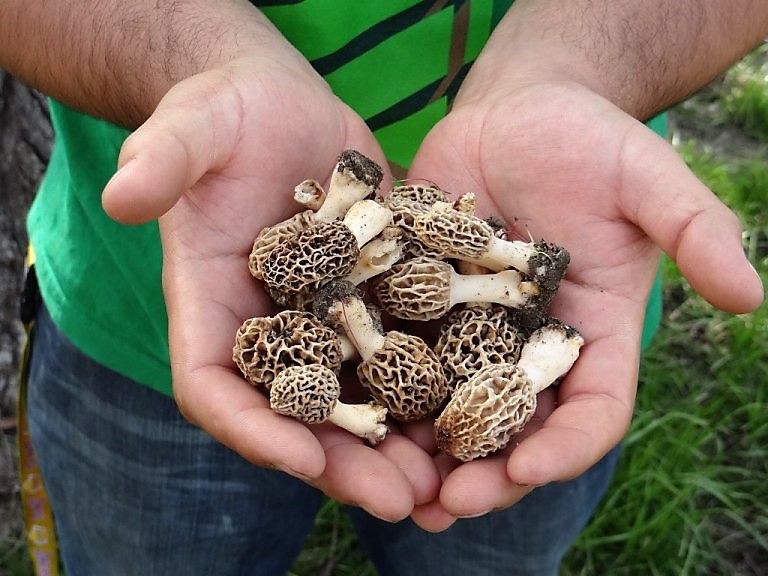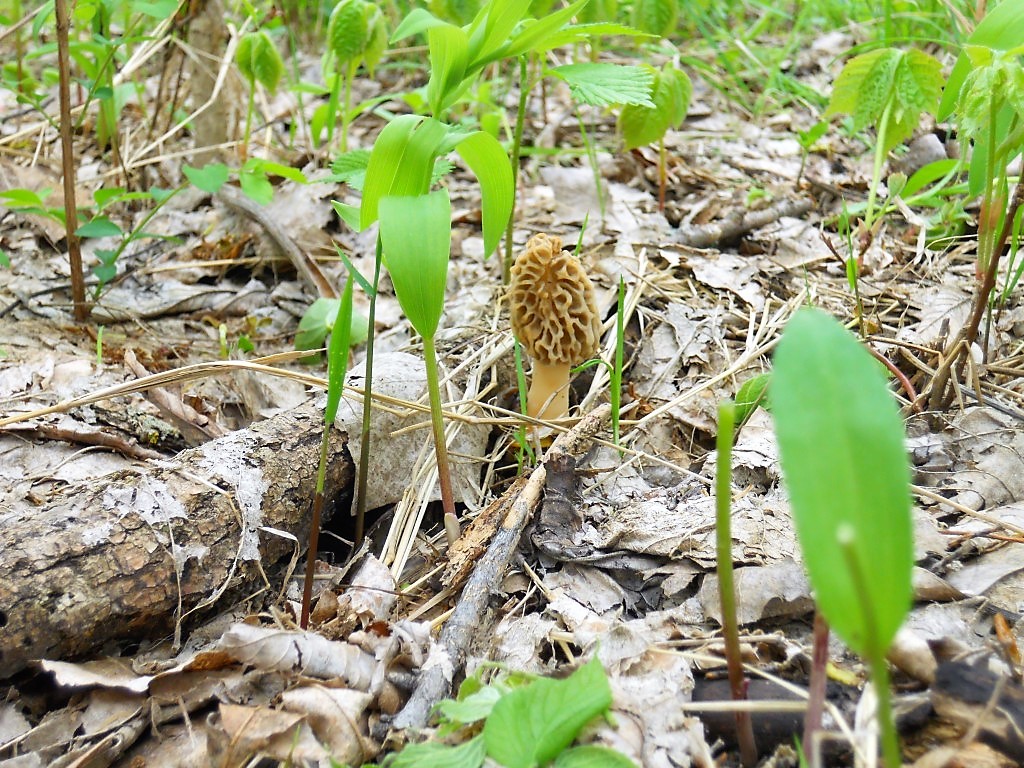The morel mushroom hunting season is literally upon us. We’re on the cusp of it along river bottoms in eastern Nebraska. A few morels have been found. The Nebraska Morels Facebook Page indicates that some morels are also being found. This is the beginning of the morel mushroom harvest season in Nebraska!

So how do we really know when morels will emerge? Among the primary indicators of morels emerging are dandelion flowers, garlic mustard seedlings, tree buds, plum blossoms, and blooming lilacs or flowering woodland phlox, but morel mushrooms are truly at the whims of nature. Their arrival is determined by weather, soil temperature, moisture, the amount of organic matter in a given wooded location and a few secrets the natural world keeps to itself.

In eastern Nebraska, look for morels near dead and decaying hardwood trees like cottonwoods and elms in moist river bottom woodlands.

Tersh Kepler is one of the foremost morel mushroom hunting experts in the Midwest with more than 50 years of experience and he points out there are some important things to know about morel mushroom hunting before venturing to the woods.

Kepler says the first morels of the season are typically the “early grays” and some “little yellows” that show up in river bottom woodlands. “Those grays blend in well and can have very tiny caps about the size of the tip of your little finger.” The best advice he offers to early season morel mushroom hunters after the small grays and the little yellows is to slow way down on your foraging expedition. “Treat it like a still-hunt,” he further emphasizes.

Kepler also advises to specifically search for morels using a star-like pattern to thoroughly comb an area for the prized culinary delicacies which have a rich, succulent, nutty, meaty, earthy flavor to them. A zigzag, crisscross pattern works to not miss any of the scrumptious fungus as well.
Keep in mind that morel mushrooms have a symbiotic relationship with certain species of trees and tree root systems.
When it comes to exactly where to find morels in mature, old growth woodland habitat, the renowned foraging expert says to look for freshly dead hardwood trees – those hardwoods that have been dead for one, two or maybe three years. He prefers to hunt for morels around dead and decaying cottonwood, elm, ash and apple trees with some bark still on them and some just bark starting to peel off.

“Read the trees,” recommends Kepler, who is also known as the tree whisperer. “Follow the limb systems from the trunk to their ends. Look up, look down. Really examine the leaf litter on the forest floor, especially where a more open forest canopy allows rays of sunlight to enter and warm the moist, loose soil. If you find one morel mushroom, there are going to be more, so keep looking. I have picked over 300 of them in one location.”

Initially, morels come out in woods along rivers like the Platte, Elkhorn and Missouri. As the morels 4 to 6 week season progresses, mushroom hunters need to eventually work their way up to moister, hilly forested areas above those rivers. The morel growing season usually runs from mid April into late May but rarely much longer. I typically find morels just after Mother’s Day in the hilly woods above the rivers in southeast Nebraska. This year the morel season could be much shorter due to weather-related conditions so mushroom hunters need to be ready to go quickly.
“If we have some sunny days after rains, take to the timber for morels!” exclaims Kepler.
The fungus needs moist, warm soil with rich organic matter.
Besides moisture content and the extent of organic matter, soil temperature is an important factor for morels. Kepler said it should be at least 50 degrees Fahrenheit some 4-6 inches below the soil surface.

It is fascinating to note that once forth, an individual morel mushroom will continue to grow for up to 7 days. After that period, the morels get mushy and then dry out. The good thing, however, is that not all of the morels in an area come up at the same time.

Anyone planning to morel mushroom hunt in Nebraska needs to know that they have to get permission before treading on private land, whether it is posted or not. Trespassing runs the risk of having mushrooms confiscated and receiving an expensive trespass citation. Theft charges may also be filed.
Morel mushroom hunters should always know and respect property boundary fences. Find out what those fences look like ahead of time.
Morel hunters must also be aware that it’s illegal to park at bridges along public roadways. Those kayaking or air boating are reminded that river sandbars and woodlands are almost always privately owned and that permission must be obtained to go there to look for morels.
Hobby picking (non-commercial picking) for morel mushrooms is allowed on Nebraska Game and Parks Commission owned and controlled lands, unless signed or indicated otherwise. A current, valid state park permit is required on motor vehicles entering state park lands.
If you hunt morels on state wildlife management areas, consider purchasing a habitat stamp. Many people do not realize that hunters who purchase habitat stamps along with their permits fund state wildlife management areas.
Open Fields and Waters program sites are not open to mushroom harvesting.
Among the necessary pieces of equipment for hunting and harvesting morel mushrooms are a good footwear (pair of hiking boots or shoes with adequate ankle support and comfort), mesh bag or well-vented collection basket or bucket (these allow morels to breath, keeping them fresh and letting some of the sand and bugs fall out while perhaps spreading spores), plus pocket knife (for gently cutting stems), walking stick (to carefully move leaves and debris out of the way to reveal morels), bottle of water (for personal hydration), insect repellent (for ticks, mosquitoes and gnats), and an iPhone or Android (for photos and to also mark spots).
If you’re interested, Tersh Kepler has a website for custom morel mushroom hunting gear he sells here.
Mushroom hunters should be careful to not intentionally disrupt wildlife or cause damage to their homes (nests, dens, etc.), and make certain to pack out all trash and recyclables.
With reference to safety when foraging for morels, always go with a partner, wear clothing colors that are conspicuous (e.g. blaze orange), apply insect/tick repellent, steer clear of spring wild turkey hunters and their camouflaged blinds on state wildlife management areas, avoid stinging nettles, poison ivy, etc., and positively identify the quarry (according to Kepler, don’t pick and eat any mushrooms red in color. “If they are red, you are dead,” underlines Kepler.)
When it comes to accurate mushroom identification, Kepler likes the old saying: “There are old mushroom hunters, and bold mushroom hunters, but there are no old, bold mushroom hunters.”
Descriptively, morels have a round to cone-shaped cap that is honeycombed with pits and ridges that resemble a sponge. Morels have a short stalk and are hollow through the cap and stem and host a warm brown to tan or yellowish color. When gathering, it is important to try to pinch the morel at the base and gently twist to break the stem or carry a small knife to cut the stem to avoid collecting a lot of dirt.

Did you know that other tasty wild edibles grow in spots near or amid the woods where morel mushrooms are found? Wild asparagus and Dryad’s saddle are among those and should not be overlooked, points out Kepler.


Morel mushroom hunting is a wonderful way to begin the foraging lifestyle and enjoy wild surroundings in the springtime. Kepler quips: “It’s a fun treasure or scavenger-type hunt with exceptionally delicious rewards.” Kepler emphasizes that kids should be included on any morel hunt for the challenge and to learn about nature. “Also, being closer to the ground, once kids get a feel for finding morels, they are likely to detect more than the taller adults,” he highlights. “Do yourself a favor and take your kids or grand kids out morelling.”

I know that you don’t need to have an excuse to be outdoors in Nebraska during the springtime, but it’s sure easier to justify when a skillet full of golden fried morel mushrooms are on the stove destined for your dinner plate!
Happy hunting (and eating)!

*NOTE: Tersh Kepler will appear LIVE on the Great Outdoor Radio Show I host this Saturday morning, April 20 from -9-10 a.m. Central Time on Omaha’s Boomer, Fremont’s Big Dog and Bluffs Country radio stations and via an app at www.MyBoomerRadio.com You can chat with Tersh on the air by calling 402.553.1490. A podcast of the program will be available after the live broadcast here: www.MyBoomerRadio.com/podcast/gw
The post What to know about morel mushroom hunting appeared first on Nebraskaland Magazine.
















